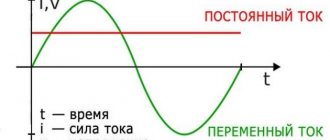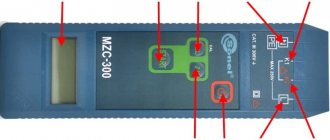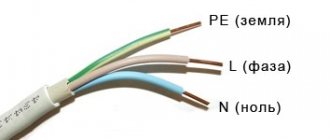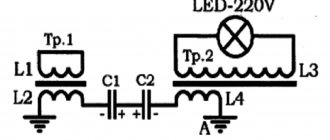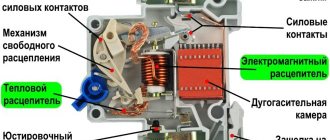To ensure proper operation of household appliances connected to the electrical network and ensure their safe operation, all connections must be made in accordance with the PUE. In electrical engineering, errors are not allowed; if the equipment is connected incorrectly, there is a risk that they will simply fail ahead of schedule, which can cause a malfunction of the entire system.
In this article we will look at the consequences of an incorrect connection and the correct procedure to avoid unforeseen situations.
Consequences of electricians' mistakes Source encom74.ru
Phase and zero: their meaning in the power supply network
The AC electrical network consists of a working phase and an empty zero. The term “zero”, used in electrical engineering, is usually understood as “working zero”. The name “phase is phase conductors.” The concept of “grounding” is directly related to “protective zero”.
Zero is intended for the constant formation of an electrical network when connecting household appliances and creating grounding. The operating voltage passes through the phase wire. For the operation of a household appliance, it makes no difference where everything is located; this is taken into account only when connecting devices.
Unlike a 2-wire cable, in which there is only phase and neutral, in a 3-phase wire the third wire is ground. Before carrying out installation work, you need to understand their findings.
3-phase wire 3rd wire - ground Source yato-tools.ru
What is phase imbalance?
This term is used to describe a network condition in which uneven loads occur between phases, which leads to imbalance. If you make a vector diagram of an ideal three-phase network, it will look like the one shown in the figure below.
Voltage diagram in ideal three-phase networks
As can be seen from the figure, in this case both linear voltages (AB=BC=CA=380.0 V) and phase voltages (AN=BN=CN=220.0 V) are equal. Unfortunately, in practice it is impossible to achieve such ideal equality. That is, the linear voltages of the network, as a rule, coincide, while in the phase voltages there are discrepancies. In some cases, they may exceed the permissible limit, which will lead to an emergency.
Example of a stress diagram when a misalignment occurs
What happens if you close zero and phase
If you connect the phase and neutral wires, you get a short circuit (short circuit). If a conductor is connected through a load, such as a lighting fixture, a “long circuit” is formed.
With this connection method, the current passes through the lamp, which is also a resistance. That, in turn, takes some of the load and converts electrical energy into thermal energy.
If you connect the conductors without a load (lamp), there is no resistance. The current strength increases many times. He tries to run away as quickly as possible while there is no resistance. For this reason:
- electrical wires;
- People;
- property is not able to withstand such a flow of powerful energy.
Electrical power has destructive power, so everything burns and melts.
Electrical power has destructive power Source ptzgovorit.ru
The short-circuit current is many times higher than the value during standard, trouble-free operation of the network. The sharp increase in current value is explained by Ohm's law. According to it, current equals voltage divided by resistance:
I=U/R.
From this formula you can easily understand that if you remove resistance from the expression and reduce it to the very minimum value, the current increases sharply. Electrical wiring is not able to withstand this amount of energy. The current has to go somewhere. During a short circuit, the wires quickly heat up and begin to melt. As a result, the protective insulation of the cable against overheating ignites.
The cable insulation ignited due to overheating Source vils.ru
There are several ways to install conductors:
- The working phase wire is determined using a screwdriver equipped with an indicator.
It is necessary to touch the live wire with the tip of the tool. At the same time, touch the point of the indicator screwdriver to the junction of the wires. When you press the button located on the back of the device, the indicator built inside will light up. The light bulb indicates the presence of potential, which means the phase has been found.
When there is voltage, the light comes on Source odstroy.ru
A significant drawback is the likelihood of incorrect operation. Sometimes an indicator screwdriver can react to interference in the electrical network. Due to this, the tool shows voltage in a place where it does not exist. It is not possible to set zero using an indicator screwdriver.
- Using a warning lamp.
This method is effective, but ambiguous; caution is required when working with it.
Determining phase and zero using a test lamp Source waysi.ru
First you need to assemble the control lamp. The easiest option is to take an electric socket with a light bulb. Wires with the insulating sheath removed at the ends are connected to its terminals. If you don’t have a socket on hand or don’t have time to make one, you can take a simple table lamp with a plug to plug into an outlet.
Using a light bulb to check the phase Source graficart.ru
Is it true that if you hold onto the wires without touching the ground, you won’t get an electric shock?
I recently watched a movie, and in it the main characters climbed over live electrical wires, but did not touch the ground. How true can this be?
Answers:
Yes, it is. Moreover, with ungrounded neutrality, you can stand on the ground.
Overhead lines are often repaired under voltage.
Have you seen a machine for repairing tram or trolleybus wires? There is such a platform on insulators on the roof. This is it.
Birds land on the wire and are not killed. In order for the current to pass through the body and strike a bird, animal or, God forbid, a person, you need to touch two wires with different potentials or a wire and the ground. And even touching one conductor with both hands can kill if your hands are spread wider and the voltage in the wire is very high. If a broken wire lies on the ground, then approaching it can also kill, if at a distance of one step a large potential difference arises, this is called the step potential. In this case, you need to get out of this zone by jumping with your legs closed.
It all depends on which wires and how to grab them.
If you hold on to one wire with one or both hands, even if it is energized, and at the same time do not touch other wires or conductive objects that are connected to a wire of another phase or “ground,” then there will be no electric shock.
If you stand on one wire or hold on to it and touch another wire of the same phase, electric shock will also not follow.
It will also not give you an electric shock if you hold on to the lightning rod wire, provided that you do not touch live wires at the same time.
In general, if you jump or jump onto a live wire and only touch it, you can stay alive, of course, if you don’t break your neck or spine when jumping to the ground.
There was an old Soviet film (1961) “The Career of Dima Gorin”, in which the very young Alexander Demyanenko (24 years old) played the main character. At the end of the film there was an episode where the main character and his beloved girl walk along the wires towards each other. If you mean this film, then: Firstly, the wires were not live. Secondly, these were three parallel wires carrying the SAME PHASE, i.e. connected to each other by jumpers, and there were three such triplets of wires (for three phases).
If you mean some other film, then the situation there is probably the same, i.e. people touched only one wire (one phase). If they clearly concerned different phases, then this is simply a hoax.
And if you imagine that a person, for example, climbs over a wire, like a climber, i.e. hanging on it with both arms and legs, then this is of course possible, but this is the middle of the process of moving along a live wire. What about the beginning and the end? Well, okay, if the wire is not very high above the ground, you can just jump off it. How do you get to a live wire? If only you throw a person onto a wire from a helicopter?
It's true that in order for a person to get an electric shock, you need to touch 2 wires or the ground.
It was very correctly noted about birds on wires; birds sit on the same wire; the current does not shock them. For example, many electricians connect under voltage; they grab any one wire with their hands and they are not shocked, although this is all individual and depends on the resistance of the human body, which is different for everyone. Many You’ve probably seen high voltage tricks where this voltage of several thousand volts is passed through your hands and you can see an arc discharge. It’s just that people have good body resistance. I personally can freely insert one nail into a socket and then grab a second nail with my hands and the current won’t kill me only tingles slightly, and the harder you squeeze the nail with your hands, the weaker the tingling
How and with what to determine phase and zero
To establish in a 2-phase network, where the phase is, where the zero is, the conductor of the light bulb is connected in turn to the wire that needs to be determined. This is done one by one with each core. For a 2-wire network, if during testing the light comes on when the ends touch, then the wire is phase, and the second is zero. In the case when the lamp does not light, it most likely means that no phase is detected here or there is no zero.
2 options for the development of events Source zen.yandex.ru
This option should not be excluded. A working electrical system is installed in a similar way, determining how correctly the electrical wiring is laid.
There is another method for determining the phase wire. To do this, the cable laid to the light bulb (control) is connected to some structure, like a precisely set zero. This could be a terminal in the electrical panel. If the other end comes into contact with a phase, the light will light up, which means the other conductor is neutral.
In a 3-wire electrical network, using a test lamp, you can establish which of the 3 conductors is zero, ground, phase.
To do this, connect the end of the wire connected to the control device with the lamp, in turn to the cable being tested. Here we will have to follow the principle of sequentially eliminating one thing after another. First, let's find the positions at which the light comes on, this means that one of the tested wires is phase, the other turns out to be zero.
Then we rearrange one of the contacts of the control lamp. Here you can fix 3 different options:
- The control lamp does not light up.
If the electrical network under test is equipped with an RCD or circuit breaker, these devices will trip. This position means only one thing: the free wire is the working phase wire, and those connected to the lamp are the neutral and grounding conductor.
Phase, zero, ground determined Source tehsistemy.ru
- After changing the position, the control lamp flashed.
In this position, the protective device or machine will immediately react, this will mean that the free cable is the working neutral, the ones being tested are the phase wire and grounding.
- There is no protection provided on the electrical circuit.
There is no protection provided on the electrical circuit.
The control lamp will light up in 2 positions. In order to establish the purpose of each of the 3 wires, it is necessary to disconnect the input cable connected to the ground loop in the electrical panel. Then, using the same meter with a lamp, all wires are checked, also sequentially eliminating one by one. If the lamp does not light up, then the grounding cable has been found.
In order to ring 3 conductors coming out of the wall, you will need an electrician's tools: an indicator screwdriver and a multimeter. Sequencing:
- Determine the phase on site using any available method.
- Locate the phase wire in the electrical panel or circuit breaker installed on the electric stove line of the stove or the entire kitchen.
- Disable protection by turning off the circuit breaker.
Just in case, before starting work, make sure there is no voltage on the disconnected power line.
- Repeat the procedure with the neutral wire and with the protective ground.
- Connect the phase conductor of the circuit breaker to zero to form a stable contact.
- Check with a multimeter set to the appropriate mode.
Are there any nuances when using an indicator screwdriver? Varieties and models
Either at school or at home, children constantly hear from their parents that current is running through the wires. And don’t put anything into the socket, otherwise it will hit you. But you can’t see the current? Or maybe he doesn’t exist? However, there is a way to find out. And even without risk to your own health. There is a unique tool that is designed just to be inserted into an outlet. It is called a screwdriver - indicator or, in simple terms, a tester. Is it worth the risk? Maybe the fears are not in vain and the current may strike? Don't worry - you are in no danger. It all lies in the special structure of this device.
How the indicator works
How does this special screwdriver work? At first glance, it looks like a regular screwdriver, but the main difference is on the inside. Externally, this device looks like all the others - this is the body of the screwdriver itself, made of material that does not allow electricity or sting to pass through. In principle, it can also tighten screws and self-tapping screws, but since this is not its main function, it is better not to use it. The blade of a screwdriver is what carries the main functionality. We plug it into a socket, or touch the wire and not be afraid of electric shock. Resistor. This part has high resistance.
Thanks to him, you will not be hit by electricity. A neon lamp (ordinary LED light bulb) is the same indicator that lights up if there is current in the circuit. The spring simply allows you to improve contact with the contact plate. Contact plate - it is in contact with a conductive object. This is logical! In this case, with you. Therefore, you should also be added to the circuit diagram. Here is the complete structure of the indicator screwdriver.
Based on this, the principle of operation is very simple. The current passes through the tip, which is inserted into a socket or attached to a wire. Next, it meets a resistor, which reduces the current strength by several times and prevents it from hitting a person. Well, in the end the neon light comes on, which signals the presence of current.
Varieties of indicator screwdrivers
All indicator screwdrivers can be divided into three types.
Classic indicator screwdriver. This is the most practical and durable device. It can lie in a toolbox for years and not require attention. But at any time he can help you when checking electrical circuits. It's inexpensive. After all, even its entire design suggests that it is so simple that the high cost simply cannot come from anywhere. Using it is as easy as shelling pears. We stuck the tip into the socket, pressed our finger against the plate and got the result. What could be simpler?
But all its advantages also turn into disadvantages. It has a high sensitivity threshold. It will only work if there is 60 or more volts in the network. Well, naturally, she needs a contact method to work.
Battery-powered indicator screwdriver with LED. It looks no different from the classic one, only inside it has an LED and a bipolar transistor. With this screwdriver, you no longer need to touch the contact plate when measuring. There are other positive aspects that can be highlighted. To determine the presence of current in a conductor, it is enough to bring the reverse side to the wire to see the result. These types of screwdrivers have wider functionality. With it you can check a piece of wire for breaks. You can simply attach one piece to the tip of the screwdriver, and the second to the contact plate. You can also test the lamp base. Just touch it with the probe. You can also find out about current entering the device body. Just touch it with your work surface. In any such cases, the indicator will wink at you cheerfully.
It can even test voltages less than sixty volts.
Such a screwdriver, oddly enough, also has disadvantages. Negative points include:
Increased sensitivity. This, as it turns out, is not only a plus, but also a minus. The indicator can work even if there is no current in the circuit. Therefore, make sure that there is nothing nearby that could affect the measurements. The downside is that there is a dependence on the battery, which, oddly enough, sometimes has to be changed.
Universal testers. Inside such devices there is already a microcircuit that significantly expands the capabilities. Switching operating modes is carried out using a slider on the screwdriver body. There are three such modes.
- Voltage determination during contact testing. At the same time, the light comes on.
- Non-contact testing with low sensitivity. The green indicator also lights up.
- Non-contact testing with high sensitivity.
Video description
What happens if you confuse phase and zero?
Here you need to ring the line at the place where the electric stove is connected to the network. To do this, the phase wire with each of the remaining cores is checked in turn. The one on which the electrical circuit is fixed is the neutral.
Connecting an electric stove Source uk-parkovaya.ru
The grounding conductor is used in the same way. We need to ring it to make sure it is definitely land. To do this, you need to short-circuit the grounding wire to the phase in the electrical panel, and then check the circuit with a multimeter in the kitchen.
This procedure will help you connect the electric stove correctly and will ensure maximum safety for all residents.
Acceptable norms of skew values
Since it is impossible to prevent and completely eliminate imbalances in three-phase networks, there are asymmetry standards that establish permissible deviations. First of all, this is GOST 13109 97; below is an excerpt from it (clause 5.5) to avoid discrepancies in the document.
Voltage asymmetry standards GOST 13109-97
Since the main reason for phase imbalance is directly related to improper distribution of loads, there are standards for their ratio prescribed in SP 31 110. We will also provide an excerpt from this set of rules in the original.
Cutting from SP 31-110 (clause 9.5)
Some clarification of terminology is needed here. To describe asymmetry, three components are used: direct, zero and reverse sequence. The first is considered the main one; it determines the rated voltage. The last two can be considered as interference that leads to the formation of corresponding EMFs in the load circuits, which do not participate in useful work.
What happens if you connect phase and zero
If the phase and neutral conductors are mixed up when connecting to the network, a short circuit may occur. Therefore, it is important to establish the true picture before starting renovation work in the apartment. To check the grounding, connect the 2 wires coming to the device and determine whether the installation work was done correctly.
During repairs, it is necessary to partially change the electrical wiring, so the electrician needs to determine the phase, neutral and ground in the network wiring boxes. Installing the phase conductor is easy; just use an indicator screwdriver (described in detail above).
Use the indicator screwdriver correctly Source psk-remont.ru
If the electrical wiring is 2-wire, there is no grounding, then one wire is phase, the other is neutral. When repairing an electrical network with 3 current-carrying cables, the question often arises: where is zero and where is ground. In terms of their characteristics, both conductors are absolutely identical. If you connect a powerful electrical appliance to a phase-ground pair, you may not even see the difference. When measuring voltage with a multimeter, almost equal voltages will be recorded between phase-neutral and phase-ground.
Some people mistakenly think that they can check 2 out of 3 wires with this device or a test lamp. It is an incorrect interpretation that where voltage appears, this is the phase wire with zero. This is not true, the potential between phase and ground or zero is also 220 V.
Lecture “How to avoid becoming a victim of a gynecologist”
Read the beginning here
So, we settled on the fact that male and female genital organs are composed of the same tissues and respond similarly to stimulation. Now let's move on directly to sexual intercourse.
Preparation
It's no secret that humans have instincts
(sexual, defensive, food).
Instincts arise automatically
, against our will, but in humans, unlike animals, the implementation of instinct
is controlled by consciousness
. A person does not rush to eat if he just wants to eat.
Consciousness control is expressed in different ways. Profound suppression of sexual instinct
, which is more common in women, is largely due to the incorrect formation of an attitude towards this automatically arising instinct, both as a result of upbringing and as a result of negative experience in the implementation of this instinct.
A person forms a strong conditional connection
between feelings of pleasure and joy and the action that brings these feelings. And vice versa, unpleasant sensations are strictly associated with what caused these sensations.
Simply put, the beginning of sexual intercourse and its first stage of “arousal” are formed not only from events that develop directly at this moment, but the body’s memories
and control of instinct by consciousness.
It is very important for a woman
after realizing the fact of possible intimacy,
make a decision
about the permissibility of this contact - give the instinct the opportunity to escape from the control of consciousness. Only in this case will all the body’s reactions begin to work harmoniously and fully.
Then the process of excitation will not turn into a confrontation between natural reactions and the suppressive influence of consciousness
.
Achieve this as best you can: champagne, atmosphere, music - enough has been written about all this in magazines and I won’t dwell on it. The main thing is to understand that without emotional, conscious consent to pleasure
, without
permission
, the effect will be bad.
Here we are talking not only about sexual intercourse, but also about independent pleasure
, since if you condemn masturbation and you are disgusted by this activity, your consciousness will definitely “crawl out” and with external signs of arousal and pleasant sensations from stimulation, the peak of pleasure
may be unattainable
.
Excitation phase
During the arousal phase, blood flow increases
to the genitals. The labia minora swell, increase in size, and become bright or even dark red. In half of women, the clitoris increases in size and its head becomes visible. The external genitalia become moist, covered with lubricant, which is produced by the large glands of the vestibule (Bartholin's glands), the small glands of the vestibule and due to the sweating of fluid from the venous plexuses surrounding the vagina.
There are now several drugs that supposedly help increase pleasant sensations.
in women during sexual intercourse.
All these drugs have the same mechanism of action - they increase blood flow to the genitals. Viagra
works in men.
But we must remember that Viagra
does
not cause sexual arousal
and does not increase desire.
Viagra and similar drugs
facilitate blood flow to the genitals in response to stimulation and sexual desire.
There were works in which Viagra was prescribed to women
, as a result, only a few women noted that their sensations improved.
Conclusion:
simple blood flow to the genitals without an emotional component
does not in any way affect the quality of sensations
, but if there is a desire, it can speed up and intensify the arousal phase.
Therefore, take advertising messages correctly.
Such drugs, as well as
vacuum devices
(for the clitoris and perineum - sold in sex shops)
can help
those women who, despite arousal, due to certain characteristics have poor blood flow to the genitals.
Further,
the vagina and external genitalia become “juicy”, the vagina lengthens, the uterus unbends and pulls up, the inner 2/3 of the vagina begins to expand.
The partner may have the feeling that the penis is “lost” in the vagina.
Plateau phase
In the process of further movements of the penis, rhythmic irritation of the nerve endings occurs, which leads to the summation of nerve impulses
and an increasing increase in sexual arousal.
The “plateau” phase
is a very
important stage
of sexual intercourse.
It is in this phase that the birth of orgasm
, and it is only this phase that
women who do not experience orgasm most often achieve
. It is important to understand what is happening at this moment, to feel these signs and then everything should work out.
In this phase, adaptation of the vagina
and towards the male genital organ, partners begin to
feel each other especially well
.
In the outer third of the vagina, that is, almost at the entrance, an “orgastic cuff” begins to form.
The orgasmic cuff occurs due to the strong blood flow to the venous plexus of the vagina in this area and to the bulb of the vestibule (see figure above).
This causes the entrance to the vagina and the outer third to swell and become very narrow
, tightly enveloping the penis.
The formation of the orgasmic cuff is a very important stage
.
On the one hand, this is necessary in order to prevent the leakage of sperm after ejaculation, on the other hand, at this moment the woman’s genitals are adjusted to the formation of orgasm.
G-spot
G-spot
- this is simply a zone in the vagina, in the projection of which there are tissues, the stimulation of which enhances pleasant sensations.
Finding this area is very simple
- you insert your finger into the vagina, strictly sliding along the front wall.
Slide along the back of the pubic bone to the top and the tip of your finger will actually be in the area where this point
. This area feels like it has a rougher surface than the rest of the vaginal mucosa.
In this small area you need to catch this point
, its location is very
individual
- some are to the left, some are to the right.
To catch it is simple - you need to moderate force
(weak pressure is not effective) with your finger in this area until you feel that the pressure brings
unusual sensations
(they are most often more strange than pleasant and can simply be characterized as a feeling that you Now you’ll “describe yourself”).
That's it - the point has been found, now about the nuances.
Video showing how to find the G-spot
Directly behind the vaginal wall in this area is the urethra (urethra) and then the body of the clitoris (the junction of its legs). At this point, the branches of the nerves innervating the clitoris converge - these branches approach from the right and left and unite at the junction of the legs of the clitoris into the body.
Around the urethra in this area there is apparently a cluster of nerve endings, which in the male body innervate the seminal tubercle in the prostate
, which, as you remember, is the main place
of formation of orgasm in a man
.
Thus, in the projection of point G
there are some very sensitive tissues: the body of the clitoris, the main nerve, the innervating clitoris and the area around the urethra, which is also called the
“female prostate”
- corresponding in location to the male prostate gland and having the appropriate innervation.
G-spot stimulation
in the absence of arousal, most often it only leads to pain and the desire to “pee,” since you are actually pressing on the urethra.
The remaining tissues at this moment are not ready for stimulation. In order for the G-spot to “play”,
it is necessary that the woman is already in a state of arousal - there is a rush of blood to the genitals, it is necessary that the clitoris has already received some stimulation and is in a state of erection.
Now back to the orgasmic cuff.
Now it becomes clear what importance
it plays
the formation of orgasm An orgasmic cuff is formed in the same place where the G-spot is located.
Due to the venous blood supply to this area, the vagina narrows, the front wall (
G-spot area
) comes into close contact with the penis (which did not happen before). The plethora of all tissues located in the projection of this point enhances the transfer of sensations from the vagina to richly innervated tissues and in particular to the body of the clitoris.
In the midst of the plateau phase
– the clitoris is pulled inward (it’s even hard to find at this moment).
At this moment, he is pulled towards his body and, in fact, to the place where all the main sensations are concentrated - the projection of the G point.
Summarized, all these sensations are resolved
by orgasm.
Conclusions:
- The G-spot
outside of arousal
is weakly sensitive
and can even be painful. - For its full stimulation
during sexual intercourse
an orgasmic cuff
, that is, venous edema must occur in this area, which will bring the
G-spot
to the body of the penis. - The sensations at the G-spot
consist of stimulation of the body of the clitoris, the nerve endings that innervate the clitoris and the area around the urethra, which is also rich in nerve endings corresponding to the seminal tubercle in the prostate gland. - The remoteness of all of these formations from the vaginal wall determines the need for fairly strong pressure
on
the G-spot
- if its stimulation is performed with fingers or a special vibrator. - The sensations that you want to “pee” at the beginning of G-spot are false
and are associated with inevitable pressure on the urethra - as arousal increases, these sensations pass. - Increased sensation from the G-spot
at the height of the “plateau” phase is due to the fact that the clitoris is pulled towards this point.
A few more facts:
- Famous exercises for training vaginal muscles
, in addition to pleasure for a man, are actually aimed at bringing the
G-spot
to the penis during sexual intercourse and increasing its stimulation, that is, enhancing the effect of an orgasmic cuff or simulating it at the beginning. - It is during the female “plateau” phase that a man most often experiences ejaculation (orgasm) - this is due to the fact that the strong grip of the penis with an orgasmic cuff significantly enhances the pleasant sensations, and the man cannot stand it. At the same time, the woman, as always, lacks “these few seconds,” that is, she remains in the “plateau” phase and does not have time to achieve orgasm.
If you have difficulty achieving orgasm , or have never experienced an orgasm, I can help you solve this problem . During the consultation, we will analyze your situation and identify the reasons that led to it. Next, I will create an individual training program for you. The offer is valid only for residents of Moscow and the surrounding Moscow region. Where to begin ? – write me a letter with a detailed description of the problem to the address [email protected] and after preliminary familiarization with the situation, I will invite you to an appointment.
I think it's clear
that
clitoral and vaginal orgasm are the essence of one concept. There is only one orgasm
, it is simply caused from two places: on one side from the clitoris, and on the other side from the front wall of the vagina (
G-spot
). A striking example for understanding: imagine a two-handed saw. You can cut a log alone, holding the saw on one side or the other - the log is sawed. Faster, more efficient and better - if two people hold the saw, that is, both handles are used. But you cannot call the same process of sawing a log differently, focusing only on which side of the log you are standing on.
Clitoris
is on the surface and its stimulation is not particularly difficult.
The G
-spot is located inside, requires some preparation and does not always have time to be involved during sexual intercourse, since the woman does not form a full-fledged “plateau” phase, both as a result of the transience of sexual intercourse and as a result of distractions (pain, emotional discomfort ).
Accessibility of the clitoris made clitoral orgasm
the most common methods of inducing orgasm, although, as I said,
there is only one orgasm
.
If a woman stimulates the clitoris during intercourse and gets an orgasm from this, she says that it was only a clitoral orgasm
, and she would like to learn how to experience
a vaginal one
.
In fact, she needs to develop a full-fledged “plateau” phase
in order to enhance the sensations from stimulation of the clitoris, which will lead to
a full-fledged orgasm
, which she will call
vaginal
, although it will simply be a full-fledged orgasm.
In general , the task of the clitoris is to initiate arousal
, then it is stimulated during sexual intercourse by touching the penis (in certain positions), and also stimuli are transmitted to it from the labia minora, which are in constant friction during the movements of the penis.
As described above, before orgasm, the clitoris is pulled inward, as if indicating that its external stimulation is no longer significant for the formation of a full orgasm. He approaches the G-spot
from the inside, to that zone in the orgasmic cuff where
a full orgasm
.
Phase "Orgasm"
During this phase, there is a rhythmic contraction of the muscles of the vagina and uterus, a sensation of strong tremors in the vagina and clitoris.
. Some women fall into a state of stupor, failure, may lose consciousness, and lose their breath. Then a feeling of warmth spreading throughout the body begins, followed by the appearance of involuntary rhythmic contractions in the genital area. These sensations are accompanied by a feeling of extraordinary voluptuousness, ecstasy that cannot be controlled, deep sighs, with tones, convulsive movements.
Orgasm intensity
may differ in one woman from light, short-lived sensations to frantic ecstasy with loss of consciousness.
The beginning of orgasm is considered to be the appearance of
rhythmic involuntary contractions of the vagina, the intensity and frequency of which increases.
Women capable of multiple orgasms
usually after the first orgasm they return to the “plateau” phase and reach orgasm again. This can be repeated quite a few times. That is, in such women, sexual arousal after orgasm drops only to the “plateau” phase and the “reverse development” phase occurs later.
The “reversal” or “resolution” phase
During this phase there is a rapid decrease in blood supply
genitals.
This process usually lasts 10-20 minutes. It is important that if a woman has not experienced orgasm,
then the plethora of the organs remains
much longer
(about 1 hour), which
is not very beneficial
for the body.
The period of immunity to new caresses (refractory period) lasts differently in women. Some take a few minutes, while others can take more than a day.
In the next part we will talk about what and how to do to make sexual intercourse complete, how to use the G-spot and dispel other mistakes and misconceptions.
My lecture “Anatomy and physiology of female orgasm and sexual intercourse”
Video description
Alternating current. Phase and zero.
In the socket terminal
Nothing bad will happen, since there is no difference to which of the contacts in the socket the phase and zero will go to. A network socket is not a USB port, which can only be connected in one position.
In newly built apartments, the electrician must carry out the wiring of the electrical network in accordance with the PUE, including the installation of sockets. When everything is done according to established standards, there is no need to rack your brains over the problem. Before connecting devices to the network, be sure to check the socket with an indicator screwdriver and determine the location of the phase wire and zero.
Why do the water tap and bathtub shock? Finding the reasons and how to get rid of them
Almost every one of us, at least once in our lives, has encountered small discharges of electric current from walls, a wet floor, a water tap, or simply water in the bathroom.
This is especially felt if there are unhealed wounds on the body and in places where the skin is thin. If you do not attach importance to this, then over time the situation may change significantly for the worse.
What to do if there is an electric shock in the bathroom? Before you can fix the problem, you need to find out the cause of it. If the tap “pinches” only once, and when you touch it again nothing happens, then you are most likely dealing with static. But when it hits constantly, then this is a “change” and you need to act immediately.
The first and most common reason why people sin is unscrupulous neighbors. Suspicions immediately arise that they are trying to steal some electrical energy and save extra kilowatts. This may be caused by their major renovation work on the apartment and the heavy loads associated with this connection - welding machines, electric heat guns, etc.
Or in winter, when the temperature of the central heating batteries is insufficient, they very often begin to use powerful heaters and heaters. Naturally, you can try to connect all this by illegally throwing wires to the wiring in addition to the meter.
The main reason for the appearance of voltage and potential in your bathroom in this case is the discharge of the neutral wire onto radiators, water pipes, sewerage and heating.
It’s true that neighbors may not always be deliberately to blame! Therefore, do not rush to immediately accuse them of stealing electricity.
In old houses with a TN-C grounding system, there is no separate grounding conductor. But many people lately still carry out wiring with three-core cables.
And on the one hand this is correct. The house will undergo reconstruction, the grounding system will change to TN-CS, and you will have everything ready. But until this moment, do not rush to connect such a conductor.
However, some, without waiting for reconstruction, simply use the risers of the nearest water supply as grounding conductors. And they immediately connect to it the very third grounding conductor. Which in turn is connected to the body of the electrical appliance.
And if the insulation of this device breaks through, then the phase will get through the pipes into the neighboring apartments.
The second reason is poor insulation of the existing wiring, which has already expired its warranty period, dried out and cracked in several places. Due to this, from time to time, electrical leaks occur on the surface of walls, pipes and other equipment connected to the bathroom. Most often, this situation occurs in apartments of old construction.
If you live on the second floor or higher, then your bathroom floor is essentially the ceiling of your neighbors below. And just the same, it may contain old wiring for lighting.
Of course, they may not feel anything, but if you get water on the floor, you may noticeably begin to receive an electric shock. Moreover, when touching any surface. You don’t go into the bathroom wearing shoes with an insulating surface, but often with bare feet.
Sometimes a frayed wire in the wall can come into contact with pipes and voltage will flow through them into your apartment.
But most often, electric shocks are possible due to a malfunction of such simple household appliances as a washing machine, titanium boiler, instantaneous water heaters, or dishwasher.
If they do not have a protective grounding, any of them will sooner or later begin to electrocute. In this case, it is enough to simply plug them into the outlet and not even start them. And when you touch the surface of this device or just water, you will begin to “pinch” in a significant way.
If there is a small leak, a slight vibration of the device will be felt.
Here all the blame lies with the heating element. Its insulation is destroyed, cracks appear, the heating coil is exposed and begins to come into direct contact with water. Hence the electric shocks.
If this is one small microcrack, then when the heating element heats up, it will open and the electric shock will be stronger. When the titanium is turned off, the heating element cools down and the crack seems to close, hiding the spiral. The tingling may be barely noticeable or disappear altogether. As the heating element deteriorates, the voltage on the tap water will remain constant.
To find out, you need to “ring” the heating element with an indicator screwdriver or a multimeter.
It's very easy to find out. Unplug the machine or plug from the heater socket and check for voltage. If it does not disappear, then go to your neighbors and ask them to do the same. When you turn off the power from a faulty water heater, the potential on the water pipes will also disappear.
The fourth reason is quite rare, but this may be your case. For example, your bathroom may not have any electrical appliances at all - no washing machine, no boiler, etc. At the same time, there are no neighbors either, and you live in your own separate wooden house. All wiring is made with a three-core cable with a grounding conductor, the panel diagram is assembled according to the rules.
And yet, you still get an electric shock in the bathroom. How is this possible?
There are two reasons:
Common problems and their solutions
If the neutral wire breaks, an emergency operation of the 3-phase network occurs. Due to the combustion of the working zero, in the case of unequal load, a very low or, conversely, high voltage is created on single-phase devices connected to this network, which exceeds the rated value characteristic of a single-phase circuit.
As a result, electrical equipment fails. This primarily applies to expensive electronic devices:
- computers;
- TVs;
- washing machines.
Such household appliances are most sensitive to fluctuations in the power supply voltage, especially to its increase.
Danger and consequences
It is believed that the most significant consequences of asymmetry are associated with poor power quality. This is certainly true, but we must not forget about other negative impacts. These include the formation of equalizing currents, causing an increase in electrical energy consumption. In the case of a three-phase autonomous electric generator, this also leads to increased consumption of diesel or gasoline.
With a uniform load connection, the geometric sum of the currents passing through it would be close to zero. When imbalance occurs, the equalizing current and offset voltage increase. An increase in the first leads to an increase in losses, while the second leads to unstable operation of household appliances or other equipment, activation of protective devices, rapid wear of electrical insulation, etc.
Let's list what consequences can be expected when a distortion appears:
- Deviation of phase voltage. Depending on the load distribution, two options are possible:
- Voltage is higher than rated. In this case, most electrical devices left plugged into household outlets are likely to fail. When the protection is triggered, the result will be less tragic.
- The voltage drops below normal. The load on electric motors increases, the power of electric machines decreases, and starting currents increase. There are malfunctions in the operation of electronics; devices may turn off and not turn on until the imbalance is corrected.
- Electricity consumption by equipment increases.
- Abnormal operation of electrical equipment leads to a reduction in service life.
- The service life of equipment is reduced.
We should not forget that misalignment can pose a threat to life. If the rated voltage is exceeded, the probability of a short circuit in the wiring is not high, provided that it is not dilapidated and the cable is selected correctly. In this case, electrical appliances connected to the network are more dangerous. When a misalignment occurs, a short circuit on the housing or fire of the electrical appliance may occur.

